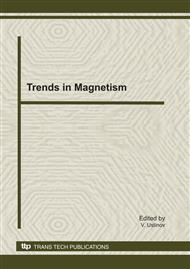[1]
S. Gaur: J. Chromatography A Vol. 733 (1996), p.57.
Google Scholar
[2]
A.N. Ratnikov, A.V. Vasiliev, R.M. Alexakhin, E.G. Krasnova, A.D. Pasternak, B.J. Howard, K. Hove, P. Strand: The Science of the Total Environment Vol. 223 (1998), p.167.
DOI: 10.1016/s0048-9697(98)00313-1
Google Scholar
[3]
R.D. Ambashtaa, P.K. Wattala, S. Singhb, D. Bahadurc: J. Magnetism and Magnetic Materials Vol. 267 (2003), p.335.
Google Scholar
[4]
H. Kahlert, U. Retter, H. Lohse, K. Siegler, F. Scholz: J. Phys. Chem. B V. 102 (1998), p.8757.
Google Scholar
[5]
M.A. Malik, G. Horanyi, P.J. Kulesza, G. Inzelt, V. Kertesz, R. Schmidt, E. Czirok: J. Electroanal. Chem. (1998), p.57.
Google Scholar
[6]
W. Jin, A. Toutianoush, M. Pyrasch, J. Schnepf, H. Gottschalk, W. Rammensee, B. Tieke: J. Phys. Chem. B. Vol. 107 (2003), p.12062.
DOI: 10.1021/jp034947+
Google Scholar
[7]
A.G. Sharpe: The Chemistry of Cyano Complexes of the Transition Metals (Academic Press, San Francisco/London/ New York, 1976).
Google Scholar
[8]
V.V. Volhin: Russ. Neorgan. Mater. Vol. 15 (1979), p.1086.
Google Scholar
[9]
T.A. Denisova, L.G. Maksimova, O.N. Leonidova, M.A. Melkozerova, N.A. Zhuravlev, E.V. Polyakov : Russ. J. Inorg. Chem. Vol. 54 (2009), p.649.
DOI: 10.1134/s0036023609050015
Google Scholar
[10]
M. Cola, T.G. Valentini: Inorg. Nucl. Chem. Letters. Vol. 8 (1972), p.5.
Google Scholar
[11]
V.G. Kuznetsov, Z.V. Popova, G.B. Seifer: Zh. Neorg. Khim. Vol. 15 (1962), p.1860.
Google Scholar
[12]
A. Ferguson, J. Lawrence, A. Parkin, J. Sanchez-Benitez, K.V. Kamenev, E.K. Brechin, W. Wernsdorfer, S. Hill, M. Murrie: Dalton Trans. (2008), p.6409.
DOI: 10.1039/b807447j
Google Scholar
[13]
C. Ni, D. Dang, Y. Li, S. Gao, et al.: J. Solid State Chem. Vol. 178 (2005), p.100.
Google Scholar
[14]
K. Tanemoto, T. Nakamura, T. Sata: Chemistry Letters (1973), p.911.
Google Scholar


